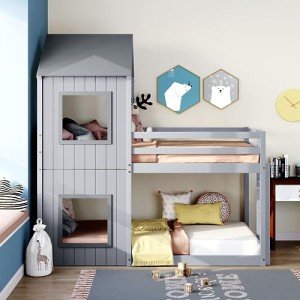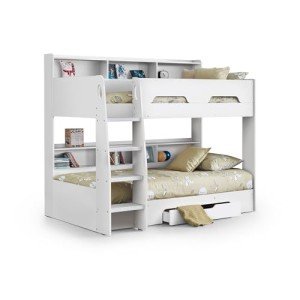
kids_bunk_beds6005
About kids_bunk_beds6005
The Most Significant Issue With Bunk Bed And How You Can Fix It
A Comprehensive Guide to Children’s Bunk Beds: Styles, Benefits, and Safety Considerations
Bunk beds have ended up being a popular option for households wanting to maximize space and provide an enjoyable sleeping environment for kids. With their unique style, they offer a creative and practical service for shared bedrooms, playrooms, or even guest accommodation. This post checks out the different designs of children’s bunk beds, their advantages, safety factors to consider, and answers some frequently asked questions.
The Allure of Bunk Beds
Children’s bunk beds are more than simply space-saving structures; they are also an entrance to daring dreams and creative play. Below is an in-depth evaluation of their many benefits.
Advantages of Bunk Beds
- Space-Saving: Bunk beds effectively use vertical space, making them an ideal option for smaller sized spaces.
- Playful Design: Many bunk bed designs include slides, tents, and themed elements, triggering imagination and enjoyment.
- Partner Sharing: Bunk beds are best for brother or sisters sharing a space or accommodating sleepovers.
- Flexible Use: Some models can be separated into 2 private beds, providing versatility as children grow.
- Storage Options: Many bunk beds include built-in drawer storage or racks, even more improving their functionality.
Designs of Children’s Bunk Beds
The variety of bunk beds available today deals with various choices and needs. Below is an introduction of some popular designs.
| Design | Description | Best For |
|---|---|---|
| Standard Bunk Bed | A traditional design featuring one bed stacked above another. | Siblings sharing a room. |
| Loft Bed | Comparable to a bunk bed without the bottom bunk, permits an office or play location listed below. | Minimal space for play/desk. |
| L-Shaped Bunk Bed | 2 beds arranged in an L-shape, often with extra areas for storage or play. | Special room designs. |
| Twin Over Full | A twin bed over a full bed, accommodating various sleep requirements. | Growing children and teens. |
| High Sleeper | Stands even higher than a loft bed, normally including a desk or play area listed below. | Older kids needing more play/desk space. |
| Camping Tent Bunk Bed | Bunk beds with a canopy or tent-like structure, developing a cozy, enjoyable space. | Active and imaginative children. |
Secret Features to Consider
When picking the best bunk bed for kids, the following functions deserve thinking about:
- Material: Bunk beds can be made from wood, metal, or a mix. Each has its unique aesthetic and sturdiness.
- Weight Capacity: Always validate the weight limit of the bunk bed to guarantee it can accommodate your children securely.
- Security Rails: Ensure the leading bunk has durable rails to prevent falls.
- Ladder Security: A properly designed ladder must offer easy and safe access to the upper bunk.
- Completing: Ensure any surfaces are non-toxic and safe for kids.
Safety Considerations
Security is vital when it comes to kids’s bunk Beds Beds beds. The following guidelines need to be followed:
- Age Appropriateness: Generally, kids under 6 years of ages need to not sleep in the upper bunk due to security threats.
- Durable Construction: Ensure the frame and products are solid and can support the weight without sagging.
- Routine Maintenance: Periodically look for loose screws, bolts, or other elements that may require tightening.
- Clear Play Area: Keep the area around the bunk bed totally free of toys and barriers to reduce tripping threats.
Setting Rules for Safe Use
Developing guidelines for bunk bed usage will help make sure security:
- Limit Jumping and Climbing: Children need to be advised against leaping from the top bunk and getting on the sides.
- Supervising Sleepovers: Monitor young visitors while they are using the bunk bed for the very first time.
- Educate on Ladder Use: Teach how to use the ladder safely, highlighting the significance of facing the ladder when climbing or down.
Frequently Asked Questions
1. What age is appropriate for a child to oversleep the leading bunk?
Many manufacturers recommend that children should be at least six years of ages to oversleep the upper bunk. This standard is created to mitigate the danger of falls.
2. Can bunk beds be personalized?
Yes, lots of manufacturers provide personalized choices, consisting of colors, materials, and extra features like drawers or desks.
3. Are bunk beds safe for weight?
Bunk beds have weight limits, normally varying from 200 to 400 pounds, depending upon the design and material. Constantly check the maker’s requirements.
4. How do I maintain and clean up a bunk bed?
Regularly check for loose parts, keep the bed clean by cleaning down surface areas, and guarantee the bed linen is fresh to promote a safe and hygienic sleep environment.

5. Can bunk beds be separated into private beds?
Lots of bunk beds come with a choice to separate them into two individual beds, providing long-term flexibility.
Children’s bunk beds are more than mere furniture; they are a practical, versatile, and creative component of a kid’s space. With numerous styles offered and many security factors to consider to keep in mind, moms and dads can choose the perfect bed that fits their space, satisfies their kids’s requirements, and instills a sense of adventure. By comprehending the advantages, styles, and precaution related to bunk beds, families can create a wonderful and protected sleeping environment for their children. Whether for siblings sharing a space or space-saving solutions, bunk beds stay a cherished choice for lots of homes.

No listing found.
